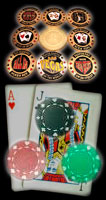DECIDING TO PLAY
If you’re a new Holdem player, or just new to the table and haven’t yet been able to identify the game conditions, the best approach is to just play tight.
There are three things you should take into consideration when deciding whether to play a hand.
1. Your position
2. How many players have already called
3. Whether the pot has been raised
Depending on these three things, tight play means different things. It doesn’t mean wait until you get pocket Aces.
Tight play means that you should only get involved when the situation suggests that the hand you’ve been dealt has an edge over the hands the other players have been dealt.
When you’re in early position, you should generally play fewer hands because of the lack of information you have about others’ hands and the risk of a weak hand being raised by a better one.
In late position, you have more information about others’ hands and can often play weaker hands if no one has raised.
Actually, in late position you can usually play weaker hands even if someone has raised.
How the number of players affects your hands depends both on how many of them have called and the position they’ve called from.
If others have called from an early position, you generally need a stronger hand.
That’s because most players who open from an early position will have a strong hand themselves.
However, if many players (generally five or more) have called, then you can play many weaker hands because you’re getting fairly good odds on your money.
If the pot has been raised, you should generally play few hands. This is especially true if the raiser cam in from an early position.
In the tables, I list some minimum hand requirements to open the pot or to call an opener under various situations.
Don’t memorize these tables. The cut-off hands I suggest are just that-suggestions.
In most cases you should be playing either tighter or looser than the tables suggest-depending on how well the others at the table play.
The better your opposition plays, the fewer hands you should play.
The worse your opposition plays, the more hands you should play. Use these tables as guidelines, not as a set of rules about playable hands.
In cases where your opponents all play badly after the flop, then you can usually loosen up even on these minimum requirements, but in many games the minimums given in these tables are probably too loose.
You should play tighter than the tables suggest. In Chapter 12, where I talk about a theory of starting hand values, I give some other hand groupings based on game characteristics that give hands value.
My best suggestion is to take the tables in this chapter and adjust them for play in the game in which you typically play based on the hand groups I give in Chapter 12.
Do your own table of starting hands based on game Characteristics and on how well you play relative to the other players.
The simplest decisions are when no one else has called yet, meaning the only thing you need to take into consideration is your position.



